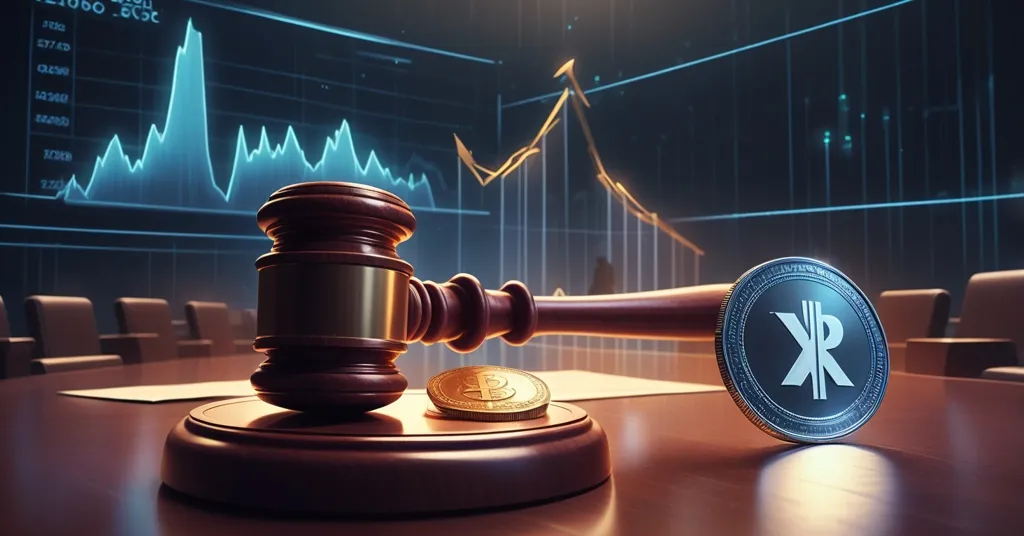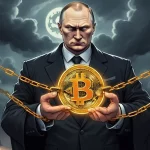Ripple SEC Lawsuit Ends with $125M Settlement and XRP Price Surge

Breaking: Ripple SEC Case Nears End with Letter to Judge Torres and $125M Settlement
The Ripple vs. SEC lawsuit, a defining battle in the cryptocurrency realm since December 2020, is finally inching toward a conclusion with significant courtroom updates. A recent letter to Judge Analisa Torres marks the start of administrative wrap-up, while both Ripple and the SEC have dropped their appeals, hinting at a long-awaited resolution. Meanwhile, XRP’s price has surged, reflecting market optimism as this legal cloud lifts.
- Letter to Judge Torres signals administrative closure of Ripple vs. SEC case.
- Mutual withdrawal of appeals by Ripple and SEC suggests end of legal fight.
- XRP price jumps nearly 6% with heightened trading volume on settlement news.
The Ripple vs. SEC Saga: A Quick Recap
For those just tuning in, the Ripple vs. SEC lawsuit kicked off when the U.S. Securities and Exchange Commission accused Ripple Labs of conducting an unregistered securities offering through sales of XRP, their native token designed for fast, low-cost cross-border payments. The central question—whether XRP qualifies as a security under U.S. law—has kept the crypto world on edge for nearly four years. A ruling branding XRP a security could have slapped heavy regulations on countless other tokens, while a Ripple win might push for lighter, tech-specific oversight. Key milestones include the SEC’s initial filing in December 2020 and a partial victory for Ripple in July 2023, when Judge Torres ruled that programmatic sales of XRP (automated transactions on public exchanges) weren’t securities, though direct institutional sales to big players like hedge funds violated securities laws. This nuanced decision set the stage for the settlement and developments we’re seeing now.
Latest Legal Moves: Letter, Settlement, and Stalled Finality
Diving into the freshest updates, a court filing reveals that Andrew Kunsak of Sidley Austin LLP sent a letter to Judge Analisa Torres requesting the removal of an investment banker declarant from the case docket. This individual, an expert witness from the finance sector who joined the lawsuit in August 2023, provided critical testimony to bolster Ripple’s defense and safeguard stakeholder interests. With their role now complete, Kunsak confirmed that the confidentiality of their input isn’t under appeal. Notably, Kunsak is also stepping away from Sidley Austin LLP, with no other firm lawyers continuing representation for the declarant—a symbolic exit as this legal chapter closes.
“The confidentiality of their testimony is not an issue being appealed,” Kunsak stated in the filing.
However, not everything is tied up neatly yet. Judge Torres recently denied a motion for an indicative ruling—a procedural step that acts as a preliminary signal from the court about its intent to finalize a decision. Despite Ripple pushing to lift an injunction and reduce a civil penalty to $50 million, and even with a settlement proposal on the table, the judge opted to keep the process grinding along. Reports now clarify that a finalized settlement amount of $125 million was agreed upon, rooted in earlier rulings. This figure, while steep, is a fraction of the billions the SEC originally demanded. It’s a financial hit Ripple seems prepared to absorb to move past this saga, though it raises questions about whether this penalty dents their operational runway or if it’s already baked into their planning.
On the appeals front, both sides have thrown in the towel. Ripple CEO Brad Garlinghouse announced the company’s decision to drop its cross-appeal in the 2nd Circuit Court, mirroring the SEC’s own withdrawal. A joint stipulation of dismissal for all appeals has been submitted, signaling that neither party sees further courtroom brawls as worth the hassle after years of slugging it out. Garlinghouse’s focus is now squarely on the future, away from legal quagmires.
“We’re closing this chapter once and for all, and focusing on what’s most important – building the Internet of Value,” Garlinghouse declared.
What’s the Internet of Value, Anyway?
For the uninitiated, Ripple’s “Internet of Value” is a vision of a global financial network where value—be it money, assets, or data—moves as seamlessly as information does online today. Through XRP and RippleNet, a platform used by banks and payment providers, Ripple aims to slash the costs and delays of traditional systems like SWIFT, which often take days and charge hefty fees for cross-border transfers. Picture a bank in Asia settling a payment with a European partner in seconds using XRP, bypassing the bureaucratic slog of legacy finance. With this lawsuit nearing its end, Ripple can push harder on partnerships, potentially convincing more institutions to adopt RippleNet without fearing regulatory blowback.
Market Reaction: XRP Price Surges on Optimism
The market hasn’t slept on these developments. XRP’s price spiked nearly 6% in 24 hours, hitting $2.56 with a range between $2.41 and $2.59 during that window. Trading volume also soared by 23%, a loud signal that investors are piling in, betting on a sunnier outlook for XRP as regulatory uncertainty fades. This isn’t just blind hype—regulatory clarity, even if won through gritted teeth, often unlocks value in the altcoin space, as seen in this XRP market analysis. While Bitcoin remains the undisputed king of decentralization and store-of-value, XRP carves a niche with speedy, cheap transactions that Bitcoin isn’t built for. Sure, some Bitcoin maximalists might grumble about Ripple’s centralized setup—Ripple Labs controls a massive chunk of XRP supply—but let’s not kid ourselves: Bitcoin has its own whale-sized influencers. XRP’s utility in payments is real, and this price bump shows the market still buys into it. The question lingering is whether this surge holds or fizzles as short-term excitement. Without deeper institutional adoption, it might just be a victory lap for speculators.
Devil’s Advocate: Not a Flawless Win for Decentralization
Let’s pump the brakes on the celebration for a moment. While the mutual withdrawal of appeals and administrative tidying suggest closure, Judge Torres’ refusal to issue an indicative ruling hints at lingering loose ends. Are there procedural snags we’re not seeing? Possibly. The SEC, despite backing off, hasn’t exactly surrendered—they’ve pocketed a $125 million penalty and cemented a precedent that institutional crypto sales can be securities. This isn’t a grand slam for decentralization or a middle finger to overregulation; it’s a gritty compromise. For Ripple, shelling out $125 million isn’t pocket change, even if it’s less than the billions initially sought. And let’s talk broader impact: the U.S. still lacks a clear crypto regulatory framework. This case sets a marker, sure, but it’s no silver bullet. Other tokens like Ethereum, with its staking under SEC scrutiny, or Cardano could still face similar battles, as discussed in this regulatory impact analysis. Applying 1930s securities laws to blockchain tech is like using a typewriter to code smart contracts—painfully out of touch. Until tailored legislation emerges, we’re stuck in a game of regulatory whack-a-mole.
On the flip side, there’s real cause for optimism. This outcome slaps back at SEC overreach, affirming that not every digital asset is a security by default, especially in public sales. It’s a partial win for the spirit of decentralization, showing innovators that pushing back can pay off. For Ripple, dumping this legal baggage means full throttle on tech and partnerships without a guillotine overhead. For XRP holders, that price pop isn’t just hopium—it’s tied to tangible progress. Could this spark wider institutional interest in altcoins for niche roles? Don’t count it out. Regulatory clarity, even imperfect, accelerates innovation—a nod to effective accelerationism that we champion. The SEC might keep playing crypto cop, but the blockchain genie is out, and it’s not squeezing back into the bottle without a hell of a fight.
Broader Crypto Implications: A Precedent with Limits
Zooming out, the Ripple vs. SEC resolution is a landmark for crypto regulation in the U.S. It curbs the SEC’s ability to slap a “securities” label on every token, particularly for programmatic sales on exchanges, which could ease pressure on other projects. Ethereum, for instance, has dodged and weaved around SEC claims on staking rewards as securities—Ripple’s partial win might offer a shield, or at least a playbook, as noted in this precedent for altcoins. Cardano and others watching from the sidelines could also breathe a bit easier, though each case will face its own hurdles. Legal experts see this as a “strategic win” for Ripple, not just for dodging worse penalties but for nudging the conversation toward tailored crypto laws over outdated frameworks. Yet, without federal legislation, the industry remains in limbo, vulnerable to the next regulatory whim. This precedent supports our push for freedom and disruption in finance, but it’s a stepping stone, not a finish line. For broader market impacts of the settlement, the effects are still unfolding.
Key Questions and Takeaways on the Ripple SEC Case
- What does the Ripple vs. SEC settlement mean for crypto regulation?
It limits the SEC’s blanket authority to classify tokens as securities in public sales, potentially paving the way for softer regulations or specific crypto legislation, though broader clarity is still needed. - Why hasn’t Judge Torres finalized the case yet?
Denying an indicative ruling suggests unresolved procedural details, reflecting judicial caution despite the $125 million settlement and appeal withdrawals. - How does this shape Ripple’s future?
Clearing legal hurdles lets Ripple focus on expanding RippleNet and the Internet of Value, likely boosting partnerships for XRP in cross-border payments and institutional adoption. - What’s driving the XRP price surge?
The 6% jump and 23% volume spike reflect investor confidence in XRP’s post-settlement outlook, tied to reduced regulatory risk and renewed faith in its payment utility. - Does this ripple out to other altcoins?
Yes, it offers a precedent that could shield other tokens from aggressive SEC action, though unique challenges remain for each project until comprehensive laws are enacted.
As the final administrative pieces slot into place, the Ripple vs. SEC outcome highlights the messy, vital clash between blockchain innovation and legacy systems. It’s not a perfect triumph for either side, but it pries the door open wider for financial freedom and disruption of outdated gatekeepers. Ripple’s next moves will be a critical watch, not just for XRP fans, but for anyone betting on decentralized tech to reshape how value flows globally. And if the SEC insists on swinging outdated hammers at unstoppable code, they’d better brace for more pushback. The fight for a freer financial future rolls on, and we’re here to track every punch. For ongoing community discussions on the settlement, the conversation continues to evolve.


